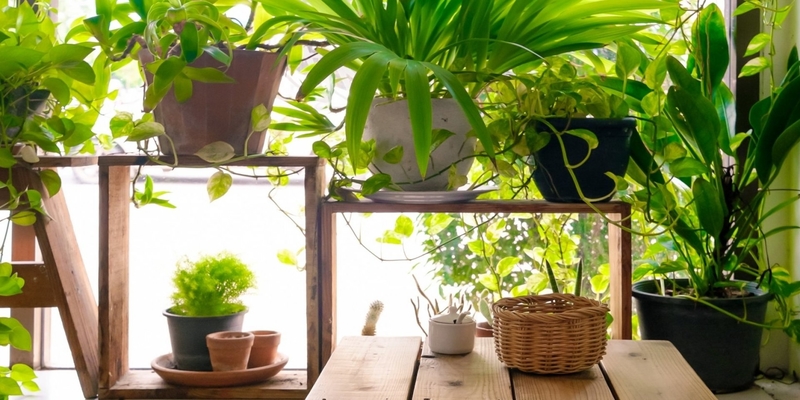Plants should be added as an essential element to every interior design or décor. Greenery in indoor spaces brightens up the room and adds a touch of elegance to it. One can easily take care of indoor plants, reap multiple health benefits, and use them for indoor decoration too; these are the reasons indoor plants are highly popular, and everybody wants to have these in their place.
Qualities to consider while choosing an indoor plant:
Ensure the roots are healthy – Checking the roots is vital before selecting a plant; although it is not practically possible to pull a plant off its pot in order to check the roots, this can be done with small-size plants. Thick and light-coloured roots are healthy.
Foliage – Remember this rule of thumb while checking a plant’s foliage; if you are trying to see through it but you can’t, it means the foliage is thick enough.
Check for disease – Disease prevention is essential. Check the plants thoroughly to ensure the plants don’t have pests or diseases. White dots, foul odour, and sticky residue on leaves are some signs of ill plants.
Common reasons indoor plants don’t survive for long:
- Underwatering or overwatering
- Not getting enough light or getting an excessive amount of light
- Negligence – not paying attention to plants’ health and growth
Here is all the information you require to make your plants flourish if you are new to growing indoor plants:
1. Pick Plants in Accordance with The Light Available
The amount of light that falls inside your rooms will help you choose plants accordingly. Here’s the thing – windows facing north give low light, east or west-facing windows provide moderate light, and south-facing windows give bright light. You can check your windows’ direction before getting plants for your room.
Bright and indirect sunlight is always preferred for most indoor plants; however, do not under/overexpose the plants to sunlight because to live, they need the right amount of light.
2. Know When to Water Your Plants
Remember to water your plants regularly but avoid overwatering and underwatering. It would help if you watered most plants once or twice a week, and even less in winters. Here’s an easy way to check your plants’ thrust; stick your finger 2 inches into the soil; if it feels dry, you should water the plant.
3. Increase Humidity Levels
Providing your plants with a natural environment will help them grow well indoors. During the dry cold months, taking similar plants and growing them in a group can help create a humid climate inside or you can use a small humidifier too. However, desert dwellers, for example, cacti, prefer dry air and bright, direct sunlight – no need for increasing humidity levels for them.
4. Check Soil Health Regularly
Use good quality soil; dark red soil is usually rich in nutrients that help plants thrive. Also, every ten days, aerate the top layer of soil by shuffling it in and around with a fork or stick. Adding a little fertilizer every two months will keep your plants healthy.
5. Utilize Your Kitchen Waste
Anything organic coming out of your kitchen (banana peels, coffee grounds, crushed eggshells, tea leaves, etc.) will provide useful nutrients to your plants. You may also save water by reusing the water used for washing veggies, grains, lentils, etc., to water plants.
6. Prune Plants on Time
According to the growth rate, give your plants a trim every three months to stimulate regrowth. Prune once your plants bloom and do this with unopened leaves and buds. Trim only the smaller branches and stems; in fact, you can remove bits like dead leaves, limp stems, and overgrown branches to make the pot look nice and neat.
7. Know Why & When to Repot
Repotting is done when needed and can be done any time; the best time is just before the plant begins to grow. Three signs a plant should be repotted;
- New leaves are growing slowly and smaller than the older ones.
- Roots are outgrowing through the drainage holes or coming up above the top layer of soil.
- Roots are tightly coiled.
8. Don’t Have Enough Time? Hire a Gardener!
Getting time for your indoor garden is essential; however, if you mostly remain busy having a hectic schedule, it would best to get a gardener on duty to take care of your plants. Hiring a gardener is always better than leaving your plants alone.
Conclusion
The points described above will help you make a perfect and healthy space out of your room. Remember, plants are vital for human life, and thus, we should grow as much as we can. This will not only benefit you and your family but humanity at large. Know more about growing indoor plants healthy from houseplant experts; download the Apni Kheti App now.
For more information about Agriculture and Livestock, download Apni Kheti app – Android, iPhone





